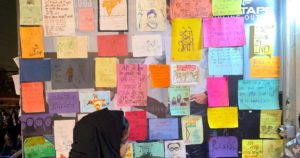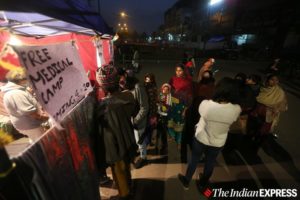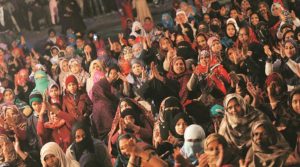
As rightly quoted by Narendra Modi, “Unity in diversity is India’s strength. There is simplicity in every Indian. There is unity in every corner of India. This is our strength.”
From only a handful of women to the entire state of Delhi supporting a cause, the sentiment of unity has percolated through the mass.
About Shaheen Bagh
Shaheen Bagh is in South Delhi’s Jamia Nagar. The area has a dense Muslim community due to its possession from the hands of Hindu Gujjars to petrodollar earners and then to the Muslim natives of Uttar Pradesh. Currently, Shaheen Bagh houses a varied class of people ranging from labourers to Professors of the Jamia Millia Islamia, nearby. This diverse class of occupants encouraged more people to join in the picket.
What is the protest about?
The 77 day long, ongoing sit-in peaceful protest at Shaheen Bagh, will undoubtedly take its place in the books of Indian History. Two days after the Parliament of India passed the Citizenship (Amendment) Act, 2019 (CAA), unavoidable discrepancies and absolute chaos among citizens eventually led to the initiation of a protest.
How did the protest commence?
On 14th December 2019, a group of 10 to 15 Muslim women gathered on the six-lane highway Kalindi Kunj Road (Road 13A) blocking the traffic as a sign of protest. Women from all walks of life, regardless of their age have joined hands to support each other. A report from India Today said that within ten days, around one kilometre of the highway was jam-packed with picketers. The numbers have just been increasing since then. Public figures, including Zafar Abbas, joined the movement to show support.
Why protest?
The primary reason for the protest was to repeal the Citizenship (Amendment) Act, 2019 (CAA), National Register of Citizens (NRC), and National Population Register (NPR). The CAA grants immigrants from neighbouring countries Indian citizenship based on their religion. These religions included Hindus, Sikhs, Buddhists, Jains, Parsis and Christians from Afghanistan, Bangladesh and Pakistan. The list, however, did not include Muslims which agitated the sentiments amongst the community. As the Muslim population outnumbered the remaining creeds, anxious and restless emotions stirred the general mass.

What happened during the protest?
This protest has sparked a sense of unity amongst the general public. Despite the harsh methods, the Government implemented to remove the blockade; the picketers did not budge.
On 30th January, four-month-old Mohammed Jahaan passed away due to the harsh cold weather in Delhi. The infant along with his mother Mohammed Nazia were regular participants of the Shaheen Bagh protest since December 18th 2020. Times of India said that “Nazia didn’t realise the severity of the boy’s congestion. He died after catching a cold that turned lethal.”
The same day, students and protesters from Jamia Milia University witnessed a terrifying incident. A man dressed in a “black jacket and brandishing a single-barrel weapon stood at a short distance from the policemen deployed outside the University,” India Today described. The man was identified as Gopal, a local of Greater Noida. He went live on Facebook, minutes before he open fired, resulting in the death of a student from the University. It was reported that he hollered “who wants azadi? I will give freedom,” before he fired. Gopal posted four live videos of the incident and mysterious posts to his Facebook timeline. One of the posts read, “Shaheen Bagh, khel khatam (game over).” Soon after, he was taken into custody and booked under the 307 IPC and Arms Act. (source: Financial Express)
After the firing, the situation at Jamia intensified. The Delhi Police increased deployment of police personnel near Jamia University to protect students and protestors. According to Financial Express, “thousands of protestors and police personnel faced off against each other near the University. The students planned to march towards Rajghat, but they were stopped near Holy Family hospital and were not allowed to move forward.”
Only three days later, protesters eyewitnessed another gunfire, though no one was injured. This time, an aerial open firing on 1st February around 4:53 pm. A news report from India Today stated that the shooter identified himself as Kapil Gujjar, a resident of East Delhi. Witnesses said that Gujjar warned them that he was frustrated due to constant protests which were a hindrance to his daily commute. The spectators added: Gujjar shouted “Hindu Rashtra Zindabad” before he fired two rounds. Delhi DCP Chinmay Biswal told Asia News International that the cops immediately overpowered and caught him on spot. Biswal added, “we recovered two empty shells from the site. The case is being filed.”
Many locals took the matter to the Delhi High Court complaining about the blocked roads which are an obstruction to the daily commute. On 14th January 2020, the Court responded stating that the case must be dealt with by the Delhi Police. The police and other authorities have “all power, jurisdiction and authority to control the traffic whenever protests or agitations are going on in the larger public interest,” the HC said (from Indian Express).
Times of India said that about 1,800 trucks cross the border point. But since the protest began, they were forced to take alternative routes.
On 17th February, a plea was sent to the Supreme Court regarding the same. The hearing was scheduled for 26th February, but it was rescheduled to 23rd March 2020 due to the North East Delhi riots between 23rd and 26th February.

What makes Shaheen Bagh stand out from the different protests that broke out is that it is not just about mere protesting, it’s so much more. The close-knit community that resides there have made sure that the people who are participating do not go through the frightening ordeal that normally comes with protests. There is an ample number of volunteers willing to tend to any of those in need. Apart from the medical camps set up, free food and drinksare also provided. Snacks such as bhujiya and biscuits are constantly being shared along with tea and coffee. It’s inspiring to see how even at a time of crisis, the people of Delhi do not give up on their empathetic nature.
The students of Delhi University manage creative art stalls where people are free to try their hand at graffiti or make a poster. The stage is mostly managed by women. Anyone wishing to use words as their medium of expression is allowed. However, ideas inciting communalism is a strict no. The women have their own systematic way of noting down the names of the speakers and sending them on stage.
Mohammad Asif, a student of Persian studies at IGNOU and a graduate from the Aligarh Muslim University, started a library at the protest site. It is rightfully named after two women whose names are synonymous with championing for the education of women and their rights– Fatima Sheikh and Savitribai Phule.

Speaking to The Week, the Uttar Pradesh-native said,
“It is for the first time in my life that I have seen so many women, otherwise cooped up in their houses, come out to the streets, forget their codes of purdah and fight for what is right.”
Asif started this library on 17th January, which marked the fourth death anniversary or as stated by many factions, the “martyrdom” of Rohit Vemula— a PhD student who committed suicide after facing extensive caste-discrimination.
Asif believes that this library will help women, who hitherto are caught in the vicious cycle of domesticity, to get educated about the status quo. “Why do you think libraries are being attacked in our universities? Because it is a symbol of protest. It teaches you to ask more questions and demand better answers,” he adds.
Akin to Asif, there is another person whose attempts to make the Shaheen Bagh resistance stand out– D.S. Bindra. A lawyer by profession who practices in the Karkardooma Court, Bindra is ensuring that the ones protesting have food available at all times. “(The women protesting in Shaheen Bagh) are not merely human beings, they are brave and courageous lionesses,” Bindra told Frontline. He is so committed to this cause that he ended up selling one of his flats in Delhi to secure funds for his langar— the community kitchen which serves aloo-poori, sabzi, dal chawal and tea.
Bindra’s cause represents a larger effort put up by the Sikh community— who did not gain any political support against CAA. On the contrary, the Badals— the political bigwigs of the Sikh community, have extended support to the BJP in the runup to the Delhi Elections. Many believe that the Sikhs have come out in solidarity with the Muslims, who faced a similar hostility from Congress, especially during the Khalistan Movement and after the assassination of Indira Gandhi.
The Women Of Shaheen Bagh

The Shaheen Bagh protest has been an ongoing sit-in protest which is led by women. Most of these women are homemakers who attend the protest after finishing their chores. Regardless of their age, religion, or occupation, Shaheen Bagh has seen women taking to the streets expressing their dissent. The women present are not only from nearby areas such as Zakir Nagar and Noor Nagar but also from as far as Dwarka and Najafgarh. Even though the capital faced the coldest winter in over a hundred years, these women stepped forward and voiced their dissent for the Citizenship Amendment Act as well as the police interventions in Jamia Millia Islamia University.
Each of them faces the fear of losing everything, from their right to worship to their right to stay alive, just by protesting. It is the constitution that they intend on defending, and this is a secular battle in which people from all faiths have become equal partners.
The women of India are leading this protest against the government. One of the reasons given for this could be that many of these women are often the first generation in their families to obtain a college education. “Anything that threatens the possibility of fulfilling their aspirations and mobility motivates them to protest against what they feel is a discriminatory law,” said Sangbida Lahiri, a doctoral student at the University of Calcutta.
How has the Indian Government reacted?
The protestors have proven to be a problem for the Government. The Government’s response is by continuously and aggressively trying to defame and discredit the protest. BJP IT cell head Amit Malviya also claimed that the women of Shaheen Bagh were being paid between 500 to 1200 rupees daily along with promises of refreshments by the Congress party to stage protests at the venue. Leading pro-government news channels have painted the protestors as anti-national and pro-Pakistani as well.
Even with the fear of losing everything, the women have stood strongly for what they believe in– a secular country where everyone is welcomed. Amidst the fear and confusion that CAA has caused, the women of Shaheen Bagh will be remembered as role models by generations to come.
The future remains uncertain for Shaheen Bagh. There is the possibility of masked men with lathis and tear gas shells thrown at them always hovering on their head. However, their bravery has inspired people all over the country. The struggle started by the Shaheen Bagh protestors is an example for all of us as to how a movement can be peaceful and life-changing even in these dark times.
Written by Kaavya Azad, Rishi Kant and Vaishnavi Karkare for MTTN
Edited by Janice Coutinho for MTTN
Source:
https://www.dw.com/en/india-citizenship-law-protests-spearheaded-by-women/a-52108903
Leave a Reply
You must be logged in to post a comment.